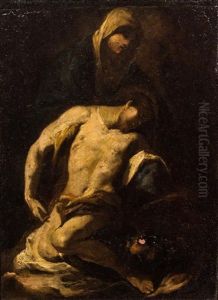Annibale Caracci Paintings
Annibale Carracci was a prominent Italian Baroque painter born in Bologna, Italy, in November 1560. He was part of the Carracci family, which included his brother Agostino and cousin Ludovico, both of whom were significant painters in their own right. Together, they opened the Accademia degli Incamminati (Academy of the Progressives) in Bologna, which played a crucial role in the development of Baroque art. The academy emphasized the importance of life drawing and the study of nature as the foundation for art, a departure from the mannerist style that was prevalent at the time.
Annibale's early work was influenced by the naturalism of the Venetian School and the vivid color palette of the Venetian master, Paolo Veronese. However, Carracci is best known for his synthesis of the robust, realistic tradition represented by Michelangelo and the Venetians' color and light. This innovative blend helped to establish the Baroque style, characterized by dynamic compositions, dramatic use of light and shadow, and emotional intensity.
In 1595, Annibale was commissioned by Cardinal Odoardo Farnese to decorate the gallery of his family's palace in Rome, now known as the Palazzo Farnese. This work, which took him nearly a decade to complete, is considered his masterpiece and one of the greatest achievements of the Italian Baroque. The ceiling frescoes of the Farnese Gallery, which depict mythological scenes and allegories, showcase Carracci's skillful use of illusionistic perspective and his ability to create lifelike figures infused with a sense of movement and drama.
Throughout his career, Annibale Carracci also produced a significant number of altarpieces, mythological paintings, and portraits. Despite his success, he suffered from bouts of depression and his health deteriorated in his later years. Annibale Carracci died in Rome on July 15, 1609. His legacy endured, influencing countless artists in the 17th century and beyond, including the great Peter Paul Rubens. Carracci's work represents a critical turning point in the history of art, bridging the gap between the Renaissance and the Baroque, and setting the stage for the dramatic and emotive style that defined the Baroque period.


